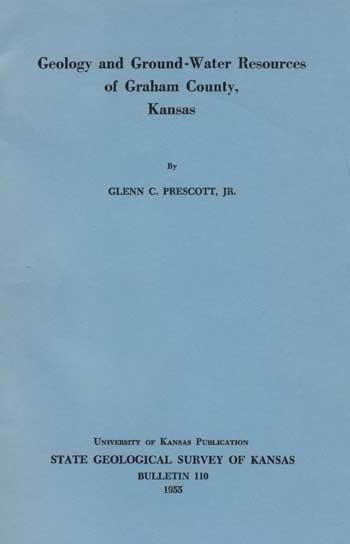Geology and Ground-Water Resources of Graham County, Kansas
By Glenn C. Prescott, Jr.

Originally published in 1955 as Kansas Geological Survey Bulletin 110. This is, in general, the original text as published. The information has not been updated.
You may also wish to visit our web site on the Graham County geologic map.
Abstract
This report describes the geography, geology, and ground-water resources of Graham County, in northwestern Kansas. Records of 344 wells and springs and logs of 31 test holes are given. The outcropping rock formations were studied in the field and a geologic map and geologic cross sections were prepared. Samples of water from 21 wells were analyzed for dissolved mineral content.
Graham County is in the High Plains section of the Great Plains physiographic province. The county is moderately to well dissected and South Fork Solomon River, Bow Creek, Saline River, and tributaries to these rivers afford good drainage to the area. The most extensive flat lands in the county are the terrace surfaces in South Fork Solomon Valley. The climate of the area is subhumid, the average annual precipitation being about 21 inches. In addition to ground water, the principal mineral resources are oil and construction materials. Farming and livestock raising are the principal occupations of the county. A very small acreage is irrigated.
The outcropping rocks in Graham County are sedimentary and range from late Cretaceous to Recent in age. The oldest outcropping rock is the Smoky Hill chalk member of the Niobrara formation, which underlies the entire county. The Ogallala formation of Tertiary (Pliocene) age overlies the Smoky Hill chalk member, but in several areas erosion has removed the Ogallala and the Cretaceous bedrock is exposed. Along many of the valleys where the Ogallala has been removed, late Wisconsinan terrace deposits mantle the bedrock. Other older Pleistocene alluvial deposits are the Crete sand and gravel member of the Sanborn formation and the Meade formation. The wind-blown silt of the Sanborn constitutes the surficial material over much of the area, particularly in the uplands. The youngest deposits are Recent alluvium along the streams aDd scattered sand dunes.
The Ogallala formation is the most wide-spread water-bearing formation in the county and yields water to many wells. In stream valleys the late Wisconsinan terrace deposits supply water to many wells and also the Crete yields water to wells. Small amounts of water can be obtained from the Niobrara formation, and from the upper part of the Carlile shale, which underlies the Niobrara. The Dakota formation, which underlies the surface at depths ranging from about 500 to 1,100 feet, contains considerable amounts of water. However, this water is of questionable quality.
The body of ground water contained in the Pleistocene and Pliocene deposits is recharged principally by precipitation that falls in the county or in adjacent areas to the west. Ground-water recharge to the Niobrara formation probably takes place in a similar manner. Some recharge to the Carlile and Dakota formations may result from local precipitation but probably the greater part of recharge to these aquifers takes place in their areas of outcrop. Ground water is discharged from Pleistocene and Pliocene deposits through transpiration and evaporation, by discharge into streams, by subsurface movement into other areas, and by wells and springs. Discharge from Cretaceous aquifers is accomplished principally through subsurface movement.
The report contains a map showing the location of wells and springs for which information was obtained and showing the depth to water level at each well. The maximum measured depth to water was 229 feet in a well to the Dakota formation. A contour map showing the shape and slope of the water table indicates that ground water generally moves into the county from the west and out of the county to the east. Geologic cross sections indicate that the Pleistocene and Pliocene water-bearing materials are too thin over most of the county for the development of irrigation wells. The most promising areas for obtaining sufficient water for irrigation wells are in the northwestern part of the county from the Ogallala formation and in places along South Fork Solomon River from the Wisconsinan terrace deposits.
Analyses of 21 samples of ground water reveal that water from the Ogallala formation, although moderately hard, is suitable for most purposes. Water from alluvial materials and from the bedrock formations is more highly mineralized than water from the Ogallala formation. Water from the Carlile shale may be unfit for irrigation and water from the Dakota formation is unfit for irrigation and may be unfit for domestic and stock use.
Kansas Geological Survey, Geology
Placed on web Feb. 13, 2009; originally published August 1955.
Comments to webadmin@kgs.ku.edu
The URL for this page is http://www.kgs.ku.edu/General/Geology/Graham/index.html